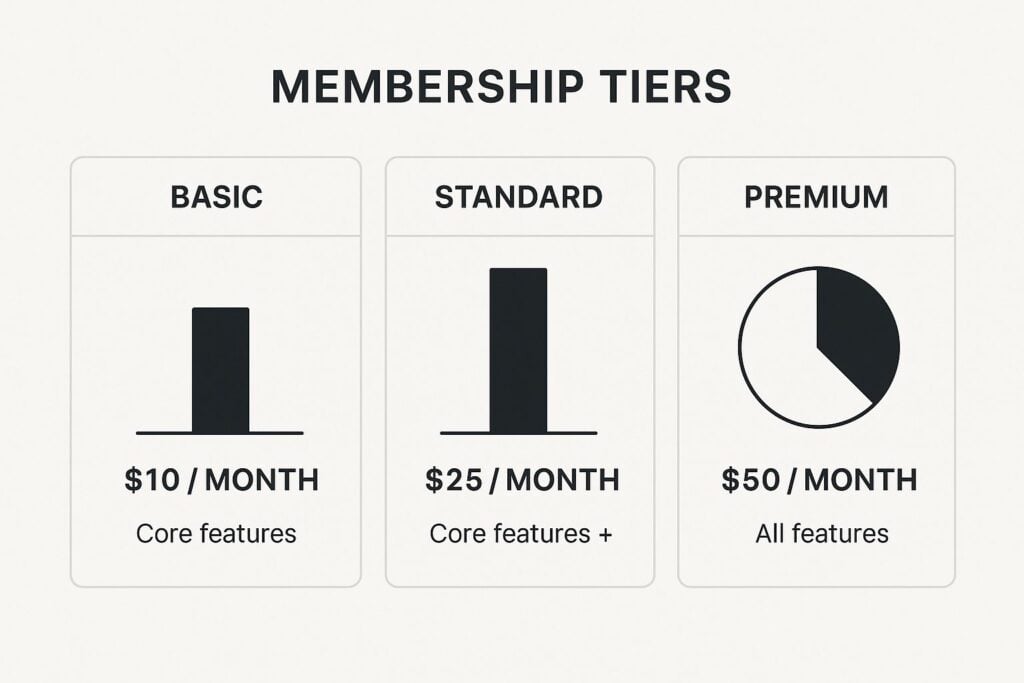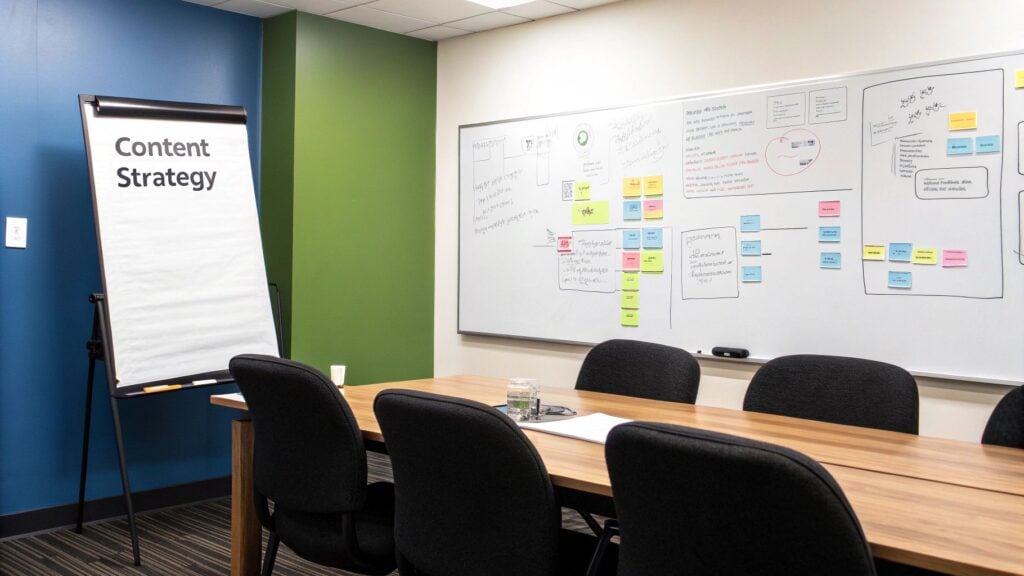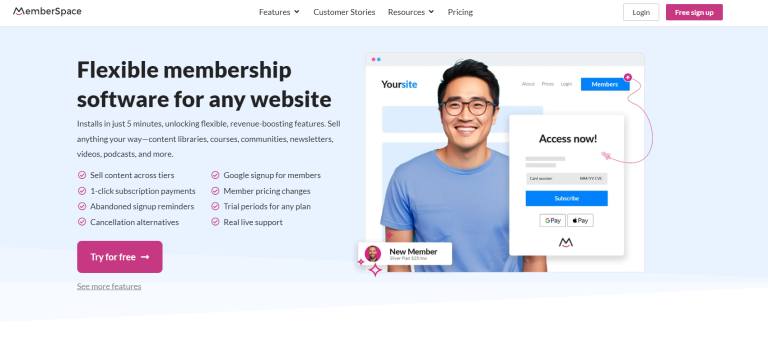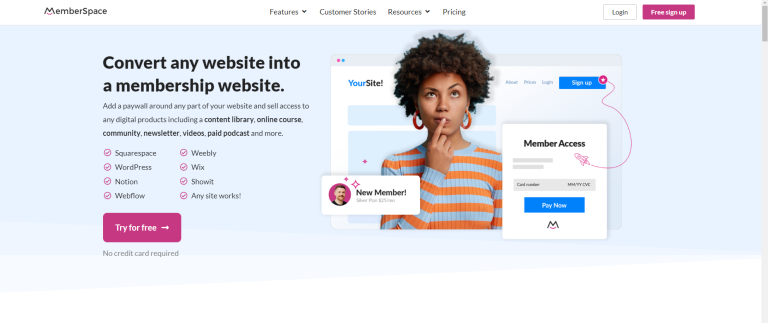How to Make a Membership Site That Thrives

Learning how to build a membership site is one of the smartest moves you can make for your business. It helps create predictable, recurring income and builds a real community around your work. The process involves knowing your audience, picking the right tech, creating content people will gladly pay for, and setting a fair price.
Think of it less as a product and more as a sustainable asset for your brand.
Why Membership Sites Are Powerful Business Models
Have you ever felt stuck on the hamster wheel of one-off sales? You make a sale, which is great, but then it’s right back to the grind of finding the next customer. I’ve been there, and it’s completely exhausting. A membership site offers a path off that wheel for good.
The biggest game-changer is predictable, recurring revenue. When you know roughly how much money is coming in each month, you can actually plan for the future. You can invest in growth, hire help, or just finally take a breath knowing your business has a stable financial foundation.
Build a True Community
It goes way beyond the income. Membership sites let you build something truly special: a dedicated home for your audience. This helps you foster genuine connection and a sense of belonging.
Think of it as the difference between a street performer and a theater owner. The performer has to win over a new crowd every single day. The theater owner, on the other hand, has a dedicated audience that shows up because they trust the quality of the experience you consistently provide.
A membership site transforms your relationship with your audience. You move from being a simple vendor to a community leader, creating a space where people feel invested and understood.
Increase Customer Loyalty and Value
When someone joins your membership, they’re making a real commitment. That deeper relationship naturally leads to incredible loyalty. These are the people who will stick with you, buy your other products, and become your most passionate advocates.
This long-term relationship is a massive advantage. Industry reports show that companies with membership models see up to a 60% higher customer retention rate compared to traditional sales models. Why? Because you’re continuously delivering exclusive value that keeps them engaged and subscribed month after month. You can dive deeper into the various membership site models to see the full potential.
Ultimately, a membership site is a business asset that grows in value over time. Every piece of content you add and every new member who joins contributes to its long-term strength. It’s a sustainable model that rewards you for building genuine connections with the people you serve.
Laying the Groundwork for Your Membership
It’s so tempting to jump straight into picking themes and plugins. I get it. The creative part is fun.
But after years of building these sites, I’ve learned a hard truth: the most successful memberships are built on a rock-solid plan, not on flashy tech.
Before we even think about the tools, we need to get brutally honest about the “who” and the “what” of your membership. This is the foundational work that makes everything else click into place.

This initial planning stage is where you figure out how to build a community that people are genuinely excited to join and, more importantly, a place they want to stay for the long haul.
Pinpoint Your Ideal Member
First things first: who is this membership really for? And I mean really. Getting hyper-specific here is your secret weapon against mediocrity. If you try to build something for everyone, you’ll end up building something that resonates with no one.
Seriously, picture one person. Give them a name. What are their biggest frustrations related to your expertise? What keeps them tossing and turning at night? Your membership needs to be the direct, undeniable solution to those problems.
For example, a generic “fitness membership” gets lost in the noise. But what about “a strength training community for busy moms in their 40s who have less than 30 minutes a day to work out”? Suddenly, it’s crystal clear. You know exactly what kind of content to create, what language to use, and how to reach them.
Defining Your Unique Value
Okay, you know who you’re serving. Now, what makes your membership the one they absolutely have to join? What’s the core promise? People don’t buy access to a library of videos. They buy a transformation. They buy a result.
Your unique value is that special blend of content, community, and access that only you can deliver.
- Exclusive Content: This could be anything from deep-dive courses and expert tutorials to a treasure trove of templates, checklists, and swipe files.
- Community Access: Never underestimate the power of connection. A private forum or chat group where members can network, ask for help, and cheer each other on is often the biggest reason people stay.
- Direct Access to You: Will you offer live Q&A sessions? Group coaching calls? Personalized feedback on their work? This direct line to the expert (you!) adds a massive amount of value.
Think about what your ideal member truly needs to succeed. Maybe they don’t need another 50-hour course to binge-watch. Maybe what they really, desperately need is a supportive group of peers and one weekly call to keep them accountable.
The magic happens when you stop selling “stuff” and start offering a clear path. Your membership is the bridge that takes people from where they are now to where they desperately want to be.
Stand Out in a Crowded Space
The online world is noisy. There’s no getting around it.
But a well-defined niche acts like a megaphone, cutting right through the chatter. Your niche is your topic, how you approach it, and who you approach it for.
A fantastic way to find your sweet spot is to combine your passion with a specific audience’s nagging problem.
Let’s imagine a graphic designer. They could create a general membership for “other designers.” It’s okay, but it’s not great. To really stand out, they could create a membership specifically for freelance designers struggling to land high-paying clients. The content? Monthly “client proposal” teardowns, project management templates, and expert interviews on pricing strategy. Now that’s a powerful, specific offer that solves a real pain point.
Map Out the Member Journey
Finally, let’s walk in your future member’s shoes. What is their experience going to be like from the moment they click “buy”? Mapping this journey out helps you create a smooth, welcoming, and valuable experience right from day one.
Think about these critical moments:
- The Welcome: What’s the very first thing they see after their payment goes through? A generic confirmation page? Or a personal video from you, a clear “Start Here” guide, and an invitation to the community?
- The First Week: How do you help them get a “quick win”? This is crucial for proving the value of their investment. Maybe you point them to your single most impactful resource or create a simple onboarding challenge.
- Ongoing Engagement: How will you keep them logging in week after week? This is where a content calendar becomes your best friend. Think monthly themes, weekly Q&A calls, or fun community challenges.
Planning this journey ensures your members feel seen, supported, and confident in their decision to join you. This groundwork is the most important part of building a membership site that doesn’t just launch, but truly thrives.
Choosing Your Membership Tech Stack
Alright, let’s get into the part that often feels the most intimidating: the tech.
Picking the right tools can feel like a massive hurdle, but I promise we can make this straightforward. Your “tech stack” is simply the collection of software you use to run your membership, from the website itself to how you handle payments.
The goal here is to find the right one for you, your budget, and how comfortable you are with the technical side of things. It’s not about finding some mythical “best” platform that works for everyone.
Two Main Paths to Consider
When you start digging into how to build a membership site, you’ll find there are two main routes people take. The first is using an all-in-one platform, and the second is building a self-hosted site, usually with WordPress and a few key plugins.
Neither path is inherently better than the other. They just serve different needs. I’ve seen incredibly successful memberships built on both.
- All-in-One Platforms: Think of services like Kajabi, Podia, or Teachable. They’re designed to be super user-friendly and bundle everything you need. That includes website hosting, course delivery, payments, and email into one package for a single monthly fee.
- Self-Hosted WordPress Site: This is more of a do-it-yourself route. You get your own web hosting, install the free WordPress software, and then add a specialized membership plugin like MemberPress to handle all the member-only features.
No matter which path you choose, your tech will need to support your pricing model. A tiered structure is one of the most common and effective ways to price a membership.

This visual is a great example of how you can tie different price points to specific benefits, making it clear to potential members why one tier might be a better fit for them than another.
Making the Right Choice for You
So, which path should you take? It really boils down to three things: your budget, your technical confidence, and your long-term vision.
An all-in-one platform is often perfect if you’re just starting out. You pay one monthly fee, and you don’t have to stress about security, updates, or making sure different plugins play nicely together. The trade-off is that you have less control over the design and functionality, and the platform’s transaction fees can start to add up.
A self-hosted WordPress site gives you ultimate control and flexibility. You can customize it to look and function exactly how you imagine. You also tend to pay lower transaction fees, which makes a big difference as your revenue grows. The catch? You’re on the hook for all the maintenance, security, and troubleshooting if something breaks. You have to be the one choosing a business website builder and all the pieces that go with it.
My best advice is to start with the simplest solution that meets your immediate needs. You can always migrate to a more powerful system later as your membership grows. Don’t let the perfect tech stack become the enemy of a launched membership.
Membership Platform Comparison
To help you see the differences at a glance, this table breaks down the key trade-offs between the two main approaches. It’s a quick way to see which option aligns best with your skills, budget, and business goals right now.
| Platform Type | Best For | Key Features | Typical Cost |
|---|---|---|---|
| All-in-One | Beginners, non-techies, and those who value simplicity and speed. | Integrated hosting, payments, email, and content delivery. Managed updates & security. | $100 – $400/month plus transaction fees. |
| Self-Hosted | Creators wanting full control, customization, and lower transaction fees. | Unlimited design flexibility, plugin ecosystem, ownership of all data. | $30 – $150/month for hosting & premium plugins. |
Deciding on a platform is a big step, but remember that the “right” choice is the one that gets you up and running without unnecessary headaches.
I’ve seen creators thrive with a super simple setup. You can actually get a powerful membership site off the ground for very little money.
Ultimately, your tech stack should work for you, not the other way around. It’s a tool to help you focus on what really matters: creating amazing content and serving your community. Choose the path that feels most manageable right now, and give yourself permission to start simple.
Creating Content That Keeps Members Engaged
Okay, you’ve wrestled with the tech and picked your platform. That’s a huge step.
But now we get to the real heart of it all: the stuff that makes people want to stick around month after month. I’m talking about the content and, just as importantly, the community.
This is where you stop selling a subscription and start building an experience, one that turns passive members into your most vocal supporters.

It’s one thing to get someone to sign up. It’s a whole different ballgame to keep them logging in, participating, and feeling like their investment is paying off. Let’s dig into how you can pull that off without completely burning yourself out.
Build a Sustainable Content Plan
The thought of constantly churning out new, amazing content can feel like a creative treadmill you can’t get off of. But here’s the secret: the goal is to create smarter, not create more. A simple content calendar is your best friend here.
Try mapping out your content a month or even a quarter at a time. This gives you a clear roadmap and saves you from that weekly panic of, “Oh no, what am I going to post this week?” Plus, it gives your members something to look forward to.
Your content plan should be a healthy mix of different formats to keep things fresh and engaging. You don’t have to do all of these, but here are some ideas that work exceptionally well:
- Cornerstone Content: These are your big, high-value pieces. Think of a signature mini-course, a deep-dive workshop, or an extensive resource library that becomes a go-to for your members.
- Live Events: There’s nothing like real-time connection. Weekly or monthly live Q&As, group coaching calls, or interviews with experts add a ton of value and make the membership feel alive.
- Quick Resources: Not everything has to be a massive production. Downloadable templates, checklists, and quick-win tutorials are incredibly useful and show you’re thinking about your members’ day-to-day challenges.
The key is consistency. Your members need to know they can count on you to deliver fresh value regularly. Whether that’s one new workshop a month or a weekly live call, set a schedule you can realistically stick with.
It’s All About Community
Content might be what gets people in the door, but community is what makes them stay. This is the glue that holds your membership together. A lively, supportive community transforms your membership from a simple content library into a vibrant home for your people.
Getting those first conversations started can feel a bit awkward, I get it. But it just takes a little nudge. I’ve found that simple, structured prompts work wonders.
A membership is more than just access to information. It’s access to connection. When you facilitate meaningful interactions between members, you build loyalty that no amount of content can replicate.
Emerging trends really highlight this shift toward community. We’re seeing the rise of micro-communities, which are small, topic-specific groups within a larger membership. These allow members to connect on a much more personal level, sharing ideas and building strong bonds. Many modern platforms support this with forums, chat channels, and other social features designed to spark interaction.
Practical Ways to Foster Engagement
So, how do you actually get people talking? Here are a few practical strategies I’ve used to kickstart engagement and turn a quiet forum into a buzzing hub of activity.
- Welcome New Members: Create a dedicated thread where new members can introduce themselves. As the leader, be the first to welcome them and ask a fun, easy-to-answer question to get the ball rolling.
- Weekly Prompts: Post a specific question each week. It could be “Share a win from this week” or “What’s one thing you’re struggling with right now?” This gives people a reason to check in.
- Member Spotlights: Highlight a member’s success or an interesting project they’re working on. This makes people feel seen and encourages others to share their own progress.
- Run a Challenge: A simple 5-day or 7-day challenge can get everyone focused on a single goal and sharing their journey along the way. It’s amazing for building momentum.
Building a community takes time and consistent effort, but it’s the most valuable asset your membership site will ever have. For a deeper dive, check out our guide on community engagement best practices.
By focusing on both great content and genuine connection, you create an experience that members will find indispensable.
Pricing and Launching Your Site
Alright, let’s get into the two parts that are equal parts thrilling and terrifying: figuring out what to charge and actually launching this thing.
Pricing, especially, can feel super awkward. It’s easy to second-guess yourself. But we’re not going to pull a number out of thin air. We’re going to be strategic.
A great launch is a carefully planned event, designed to build a groundswell of excitement and draw in those all-important first members. These are the ones who will set the tone for your entire community.
How to Price Your Membership
Deciding what to charge is more about the value and transformation you’re delivering than what you think people will pay. A tiered pricing model is a fantastic way to approach this because it lets you meet people where they are, both in terms of their needs and their budget.
Here’s how that might look:
- Basic Tier: This is the front door. It could offer access to your core content library and community forum. It’s a perfect entry point for someone who’s curious and wants to get a feel for what you’re all about.
- Premium Tier: This level is for people who want more. It might include everything in the basic tier, but you’d add in exclusive content like monthly live Q&A calls, expert workshops, or even direct access to you for feedback.
- VIP Tier: For your most committed members, this could offer high-touch benefits like one-on-one coaching, personalized roadmaps, or other premium perks.
Also, think about offering both monthly and annual plans. An annual plan, usually with a nice discount, is a game-changer for your cash flow and rewards your most loyal members. It’s a true win-win.
Special Offers and Launch Pricing
When you’re first opening the doors, creating a special offer for your founding members is a seriously powerful move. It is a way to thank the people who believed in your vision before anyone else did.
You could offer them a lifetime discount, an exclusive “founding member” badge in the community, or extra bonuses that will disappear once the launch is over. This creates a sense of urgency and makes your early adopters feel genuinely valued. If you’re debating what kind of offer to make, our article on free trials versus a low entry fee for memberships can help you weigh the pros and cons.
Don’t be afraid to price based on the outcome you provide. People are not just buying access to videos or downloads. They are investing in a solution to their problem. Frame your price around that transformation, and it will feel like an incredible deal.
Planning Your Launch Sequence
A successful launch is all about building anticipation. You want people practically lining up, ready to join the moment you open for business. Here’s a simple sequence that I’ve seen work wonders time and time again.
Build a Waitlist
Weeks before you even think about launching, get a simple landing page up that teases what’s coming. The only goal here is to collect email addresses from anyone who’s interested. You can offer a small incentive for signing up, like a free guide or a promise of an early-bird discount. A solid landing page is non-negotiable for converting visitors into paying members. You can learn more about crafting high-converting landing pages for lead generation to really dial this in.
Create Buzz
Start talking about the membership everywhere, on your social channels, in your blog posts, and on your email list. Share some behind-the-scenes sneak peeks of the content you’re creating. Run polls asking your audience what they’d love to see inside. This gets them invested and makes them feel like they’re part of the process.
The Email Launch
Your email list is your single most valuable asset during a launch. When it’s go-time, send a series of emails to your waitlist announcing that the doors are officially open. Hammer home the benefits, share any testimonials you might have, and remind them about the special founder’s pricing they’ll get for being early.
This structured approach helps you launch with a burst of momentum and lock in those first crucial members who will breathe life into your new community. And once they’re in, the real fun begins: delivering an incredible experience. The data is on your side here. Membership renewal rates have a median of 84%, which just goes to show that once people see the value, they’re very likely to stick around.
Common Questions About Membership Sites

You’ve seen just how many moving parts are involved in getting a membership site off the ground. It’s completely normal for questions to bubble up as you go. Honestly, I get asked the same handful of questions all the time by creators just starting this journey.
So, I’ve pulled together the most common hurdles I see. The goal here is to give you quick, no-fluff answers so you can make clear decisions and keep building momentum.
How Much Does It Really Cost to Start?
This is easily the question I get most, and the real answer is: it depends. The cost to get a membership site running can vary wildly, but the good news is you can absolutely start lean.
If you go the self-hosted route with a WordPress site, your startup costs can be surprisingly low. You might be looking at a couple of hundred dollars for a great plugin like MemberPress and your yearly web hosting. It’s a fantastic, budget-friendly way to get going with total control over your platform.
On the other end of the spectrum, you have all-in-one platforms like Kajabi or Podia. These typically start somewhere between $40 to $150 per month. While that sounds like more, remember that fee often wraps in your hosting, video tools, email marketing, and support. It simplifies things a ton.
The biggest costs are almost never the technology itself. They’re the time and resources you invest in creating your content and marketing your membership to the right people.
My advice is always the same: start small. Pick a cost-effective platform that lets you prove your idea works first. You don’t need the most expensive, feature-packed setup on day one. You can always level up your tech stack as your member base and your revenue starts to grow.
How Much Content Do I Need Before I Launch?
This is another huge source of anxiety for new creators, and I get it. You want to deliver incredible value the second someone signs up. But you almost certainly need less content than you think.
You absolutely do not need a massive, all-encompassing library of content on launch day. The goal is to provide an immediate, tangible win for your new members. They’re investing in the journey with you, not just buying a static archive of stuff.
Here’s a simple rule of thumb to follow:
- Have one cornerstone piece ready. This could be your signature mini-course, a valuable resource library filled with your best templates, or a series of welcome workshops.
- Create a clear content roadmap. Let your founding members know what you plan to release over the next three to six months. This shows them you have a vision and gives them something exciting to look forward to.
- Focus on a “quick win.” Guide new members to one specific piece of content that can help them solve a small problem right away. This builds instant trust and proves the value of their subscription.
What Are the Most Common Mistakes to Avoid?
I’ve seen a few common pitfalls trip up even the most talented creators. Just being aware of them can save you a world of frustration down the road.
The single biggest mistake is obsessing over the technology while ignoring the community and the core promise of your membership. People will spend months tweaking their website design but haven’t actually spoken to a potential member to find out what they truly need.
Another classic pitfall is inconsistent engagement. A membership isn’t a “set it and forget it” product. It thrives on your presence. You have to show up for your community regularly, whether that’s through live calls, answering questions in the forum, or releasing content when you say you will.
Finally, please, please don’t underprice your membership. It’s so tempting to set a super low price to get as many people in the door as possible, but this is often a recipe for burnout. It can also unintentionally devalue your expertise. Price your membership based on the transformation you provide, not just the quantity of “stuff” inside.
How Do I Keep Members from Canceling?
Reducing churn is the name of the game for long-term success. Getting people to sign up is only half the battle. Keeping them happy and engaged is what builds a sustainable business. It really boils down to delivering consistent value and fostering a real sense of community.
First, you need a fantastic onboarding process. Your welcome sequence should make new members feel seen, celebrated, and smart for joining. More importantly, it should clearly show them exactly how to get the most value from their subscription right from the first login.
Second, you have to engage with your members consistently. The most successful memberships I’ve seen are the ones where the leader is present and active. Jump into your forum, host regular live events, and make your members feel like they’re part of something special.
Lastly, make a habit of listening to feedback. Send out regular surveys. Ask members what content they’d love to see next or what features would make their experience better. When people feel heard and know their input matters, they become deeply invested in the community’s success and are far more likely to stick around for the long haul.






